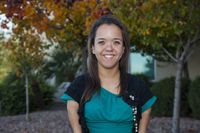Diversity and dwarfism: Life as a little person
Posted: May 6, 2014
“When someone says ‘no’ to me, that makes me want to do it five times more,” says Jessica Markbreiter, AT, ’15. Her independence and determination have served her well—though she is small in stature, Markbreiter is accomplishing big things.
Markbreiter has Achondroplasia Dwarfism, a genetic mutation that results in shorter limbs and a standing height of four feet tall. Achondroplasia is the most common form of dwarfism along the spectrum.
There are many challenges associated with dwarfism. Dwarfs often experience chronic health issues, from bone and joint pain to bow legs and narrow spinal columns. Markbreiter has undergone two surgeries on her neck and back to widen her spinal cord.
The social challenges are equally extensive. As a youth, Markbreiter says elementary school was difficult, with peers who teased and bullied her. But, her experience got better as she grew older. Looking back now, she laughs. She has grown to accept her diversity.
“Instead of identifying my difference as a crutch in my life, I use it to set myself apart and make it a unique characteristic about myself. I am always eager to educate others about dwarfism and to answer questions they may have,” she says.
On a day-to-day basis, Markbreiter doesn’t consider herself different from others. Even though she may need to stand on the wastebasket to reach the sink or use water from the bathtub to brush her teeth in a hotel room, she accomplishes tasks with confidence and ease. It doesn’t faze her to climb up on countertops in front of classmates or co-workers to reach into cabinets.
“Everything I do, I have to adapt. It’s part of my nature,” she explains. “I don’t think twice about doing something differently than everybody else.”
Her car is modified to fit her small stature, with pedal extensions and safety features such as disarmed air bags. At home and work, chairs and stools are right-sized to accommodate Markbreiter.
Inspired by her high school gym teacher to pursue athletic training, Markbreiter is now a first-year AT student at ATSU. Although it is challenging, and she doesn’t know of any other short statured athletic trainers, Markbreiter is excited to pursue a profession in healthcare.
“It is tough, especially with the physical demands,” she says. “I find ways to make it work. I could be as negative as, ‘Well, I can’t do it. ’ Then what am I going to do with the rest of my life? But, I just choose not to do that.”
Her patients are curious and receptive.
“Once I tell them, ‘I’m just like you,’ they get over it,” she says. “I may be small, but I can still stretch you. I can still treat you.”
“I don’t think twice about doing something differently than everybody else.”
Culturally, dwarfism often receives negative attention, stemming back to 19th century mythology. In art, literature, and Hollywood, dwarfs are typically depicted as non-human, mythical, and even divine. While dwarfism is more socially accepted today, there is still a fine line between how little people are depicted and how they want to be perceived.
Reality TV shows such as “The Little Couple” and “Little People, Big World” show the “real” lives of people of small stature. The stars of these shows have careers, families, and homes, and prove dwarfs are neither strange nor mythical. Markbreiter doesn’t keep up with the shows due to her busy schedule, but she recommends them nonetheless. It’s a positive way to spread dwarfism awareness, and it creates a conversation starter.
“Everyone will ask me if I know Matt Roloff [of “Little People, Big World”],” laughs Markbreiter. “I don’t see the glitz and glamour of it, but it’s great for people to be exposed to that.”
In the media hubbub following the 2013 MTV Video Music Awards, it seemed the whole world was talking about the Miley Cyrus and Robin Thicke performance. Markbreiter reveals that she was more focused on what was happening in the background of said performance: The stage dancers dressed as teddy bears were little people.
“Some people say that’s a great career and others see it differently. But you have to realize that now, that is how people are going to see you, and we are more than just a person dressed in a costume playing a role. I, like many others, want to be seen as equal to all of my peers.”
Regardless of the media’s perception, ATSU sees Markbreiter the same way it sees each of its students—as passionate individuals seeking to use their graduate degrees to do good in the communities around them. Markbreiter happens to be a person of short stature, and from the University’s perspective, that’s value added for fellow students.
WEB EXCLUSIVE What is diversity at ATSU? Watch and learn at www.atsu.edu/diversity.
“Our students are better served when they interact with students who are different from them,” says ATSU Diversity Director Clinton Normore, MBA. “My mission is to infuse the idea of difference in every aspect of our academic environment.”
Diversity means differences, and at ATSU, differences bring value to all.
“I am so grateful that my difference has been embraced at ATSU,” Markbreiter says. “The support I have received from everyone at ATSU is something I would have never imagined. ATSU isn’t just my school; it is my home away from home.”